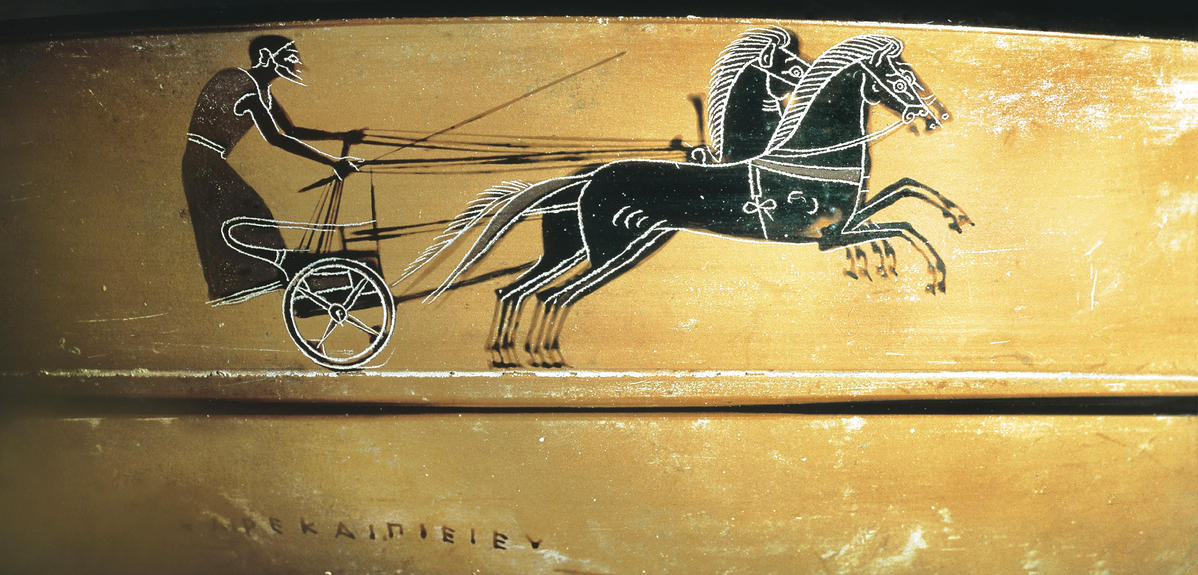You are here
Ancient Olympic fans also cheered for their heroes

Is it accurate to say that the modern Olympic Games were invented in ancient Greece?
Jean-Paul Thuillier1: That’s what the name would imply, but today’s games have virtually nothing in common with the ‘contests’ or ‘gatherings’ (agônes) that were organised in Olympia starting in the 8h century BC. When Pierre de Coubertin invented the modern Olympics between 1894 and 1896, the idea was to democratise sport by making it international. However, in antiquity the concepts of amateur sport and the nation-state simply did not exist. In addition to this crucial difference, there were far fewer sports disciplines – mostly horse races and athletic events, and no team sports at all. The ancient Greeks played some ball games, but never in Olympic competitions. Lastly, we must bear in mind that the contests were dedicated to the gods as one part of a whole series of ritual events: processions, prayers, sacrifices, etc. – which obviously is not the case today. In short, we are talking about two very different realities. I also think it’s telling that the first modern games were held in Athens and not Olympia. In 2004, the Organising Committee used the Olympia Stadium for the shot put event, as a symbolic gesture. I found it amusing, given that there was no such sport in ancient times!

Were similar competitions held elsewhere in the ancient world?
J.-P. T.: Indeed, sport was not born in Greece, contrary to popular belief. Older practices have been identified in Egypt and in the Sumerian civilisation, for example. It is true, however, that sport took on considerable and relatively unprecedented importance in the Greek world. ‘Gymnastics’, i.e. physical training in the gymnasium, was an integral part of a proper upbringing for members of the elite, alongside intellectual education. Moreover, the competitions held in Olympia became the largest gatherings that Greece had ever known: 50,000 spectators would come to see the games – a considerable figure at the time.
Starting in the 4th and 3rd centuries BC, and under the Roman Empire, competitions multiplied around the Mediterranean, in modern-day Turkey, Tunisia, Egypt, Italy… I believe it was the ancient Romans who invented what we now call the ‘spectator sport’. The famous circus games – which, I should point out, did not include gladiator fights – drew as many as 150,000 spectators. They remained the largest-ever sporting event until quite recent times: Maracanã Stadium, built in Brazil in 1950, finally broke the record by accommodating up to 200,000 people, before being scaled back to a more modest capacity.
What distinguished the Roman games from the Greek Olympiads?
J.-P. T.: The Greek athletes were aristocrats who were motivated primarily by the desire to win and be crowned with glory. Olympic champions were viewed with the same esteem as a military leader who had saved his homeland. But their only tangible reward was the olive wreath they received in Olympia, and possibly some material goods or money back in their home city. In Rome, things were completely different: the aristocrats would never put themselves on display, which was viewed as disgraceful. The people who participated in the games were of low status, often slaves competing in the hope of earning money, improving their condition or being freed. The greatest champions of the main event, the chariot race, earned huge fortunes: a certain Diocles is known to have won 35 million sesterces, whereas the minimum fortune of a Roman senator – the highest status of the time – would have been no more than one million. This gave rise to the first major debates on ‘sport business’ and the remuneration of champions. Intellectuals like Juvenal and Martial were outraged and denounced these ‘excesses’ in their poems.
Was money less of a factor in Greece than in Rome?
J.-P. T.: The Roman chariot races were in many ways the equivalent of modern-day football: the competitors could come into sizeable sums of money and generated an enthusiasm unparalleled in ancient history.
Not even the other circus game events – primarily combat sports and athletics – commanded such popularity. In Greece, horse racing was reserved for the elite and the wealthiest citizens, so there was less money involved. The very earliest beginnings of professionalisation can be seen starting in the 4th century BC: competitions proliferated in the Mediterranean region, more and more often rewarding the winners with sums of money. Some athletes earned a living travelling from one competition to the next. But this was a later phenomenon, and only marginal in what we call the ‘Panhellenic Games’.
Did these events have a political or social function?
J.-P. T.: Yes, first of all because they drew very large crowds. In Greece, people went to the sanctuary of Olympia as others would later go on pilgrimages to Mecca. Many came to see the show, to participate in the event, but there was more to it than that. It was also a meeting place, an opportunity for politicians, orators and philosophers to exchange ideas and make themselves known. In Rome, especially in the Republican era, the Games were an instrument of power. The magistrates in charge of organising them – the ‘aediles’ – were sure to have an illustrious political career if they put on a lavish event. The emperor could also derive great prestige from the games – a fact that was denounced, once again, by the writer Juvenal, who lamented that ‘All Rome is in the circus today’. The popular success of the games was such that the streets were deserted during the chariot races, incidentally giving thieves a free hand. The fans were electrified in the stands, endlessly arguing who was the best charioteer. The Satyricon, by the author Petronius, even describes a master debating the subject with his servants. This created exchanges between very different types of people, and thus a form of social cohesion.
Were the fans who attended the games much different from those of today?
J.-P. T.: They behaved more or less like the tifosi in Italy or the Paris Saint-Germain football fans. In Rome, they were already selling sports merchandise: terracotta lamp medallions depicting charioteers, statuettes, small folding knives made of bone engraved with the names of champions and their horses… I should mention that there were four factions of charioteers identified by different colours. In the stands around the circus, the spectators would shout, ‘Come on the Greens!’ or ‘Come on the Whites!’ As an interesting aside, a tomb from that era has been discovered with an epitaph saying ‘Venetianus’, which could be translated as ‘supporter of the Blues’. It would be like a football fan’s headstone summing up his life with: ‘He always rooted for Olympique de Marseille’. In fact, the modern equivalent actually exists: I’ve seen a football engraved on someone’s tomb – I think the practice is rather common in Latin America, for example. Ancient sporting events aroused the same emotions that we see today. The spectators were excited by the performances of their champions, applauding them and jeering at the opponents. Of course, things were quite different, especially from a religious and political point of view. But when a favourite charioteer crossed the finish line ahead of the pack, and the crowd roared with joy, I think the spiritual aspect was no longer of great importance.
- 1. Professor emeritus of ancient history at the École Normale Supérieure’s Archaeology and Classics of East and West unit (AOrOC – CNRS / ENS / EPHE).
Explore more
Author
Fabien Trécourt graduated from the Lille School of Journalism. He currently works in France for both specialized and mainstream media, including Sciences humaines, Le Monde des religions, Ça m’intéresse, Histoire or Management.



















